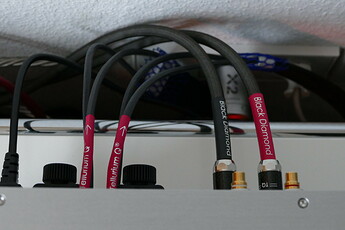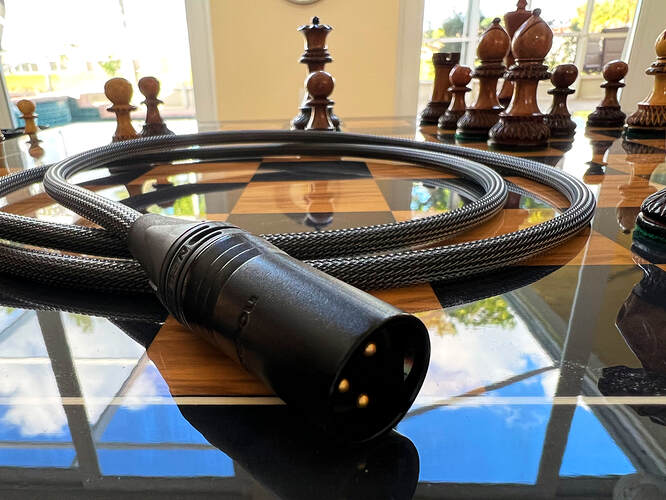Since my system is fully balanced from the DAC output to the power amp’s outputs (Vivaldi > fully balanced preamp > fully balanced Class A monoblock power amps) I use XLR throughout.
Audioquest WEL Signature shows the best synergy with my amps.
No doubt a very good cable ( sadly beyond my price bracket). However for others who may wish to try your suggestion please ensure that you purchase them from an authorised dealer. There are fakes about. A friend returned his to AQ for re-termination only to have them retained as counterfeit.
IMHO up to 15% of the total system investment for analog interconnects is justifiable as long as I can clearly hear the sonic differences.
Audioquest Fire both from dCS to Pre and from Pre to Amp.
Very expensive cables, but my quest has ended, AQ Fire are gorgeous.
They are, but try Synergistic Research Atmosphere X Euphoria.
I had them on loan, with the brick for grounding, I preferred the Fires (more neutral) … on my system to my ears.
I think at this level of quality it ends being a matter of system synergy, personal tastes and type of music.
Of course corporates such as Google, Apple will normally only purchase products from established blue chip companies such as Cisco. It can be a nightmare dealing with “the Purchasing/Procurement department”.
I’ve been happily using cables made by Chord Company, also like the way they look. However in the last half a year or so, partly prompted by the need for additional cables for my home office setup, and partly due to a mild case of neurasthenia (ok I made this up, it was plain boredom), I’ve started to make my own cables. Using Mogami Neglex Quad with twisted pairs into top of the line Neutrik connectors, finished to commercial grade complete with heat shrink and braided sleeving no less. They sound fabulous, every bit as good as those costing many hundreds. And no, there’s no confirmation bias, I actually expected them to not perform as well.
Can I order a pair of XLR 1m Wilson Cables, please 
If you were states-side I’d gladly have made you a pair for free—I still have some leftover material.
They look great! Thanks for the offer, appreciated.
More or less in this cable topic… I’m trying the “diagonal” connection to my speakers (as Audioquest ,Nordost and Chord suggest as a possibility, not mandatory) and I’m very surprised the better sound balance and improvement with my two different speakers , B&W 802 D and JBL 1600 HDI . I don’t know exactly why but the difference is obvious! Both so different speakers sounds better, more focus center image, more clarity, very good bass detail , with diagonal wiring: Red+ wire, to Red +speaker for Highs-Medium an Black - to Black - speaker connection for low frequency. ( Using jumpers made with the same Tellurium cable I’m using) . Someone try this “diagonal” connection with same good results as me? First I think it was some kind of suggestion, but testing more and more I’m sure is real and try it is free.
I’m using Transparent Audio XL Gen 6 throughout my system (XLR) and I love them. I’m going to replace power cords pretty soon with TA as well.
I tried similar on my Von Schweikert speakers and ended up with this in descending order of preference:
- Two separate pairs of cable on each side. As in: four speaker cables for one pair of speakers.
- One pair of speaker cables, with diagonal jumpers (same cable as the main speaker cables).
- One pair of speaker cables, H/T first, then down to woofer.
- One pair of speaker cables, woofer first, then up to H/T.
- One pair of speaker cables, supplied metal bar as a jumper.
I think much more discussion on speaker cables would be off topic for this thread though, @AMdeC, so maybe starting another topic would be good. Didn’t want to leave you hanging though!
Bringing it back on topic: I’ve tried a few different interconnects and reasonably recently moved from Tellurium Q Silver Diamonds to Iconoclast OCCs. XLRs to my speaker amps and RCAs (inbound) for my headphone amp. Absolutely love the Iconoclast cables. (I am not on commission.)
I have also recently bought Iconoclast UPOCC XLR and OFE speaker cables, and I’m very happy with what I’m now hearing!
Any Townshend Allegri Ref owners;
Do you have a preference for XLR or RCA between your DCS and Allegri ? At the moment I use RCA and then have RCA from pre to a Leak Stereo 20 or XLR to big monos, which hum slightly with RCA.
Dodgydoc, something that you may want to bear in mind. When you compare an RCA connection v. an XLR connection using a dCS DAC you are not just comparing the wires and their configuration.
The dCS’ RCA output and XLR output feature completely different circuits . The RCA circuit is an op.amp design and the XLR one is fully discrete. It is widely held that the XLR output has somewhat better sound ( though that should not short change the very good RCA one).
Further, although Allegri is single ended, the XLR input is wired as quasi- balanced so although the noise rejecting advantage ( CMRR) can’t be utilised as it would in a fully balanced connection it should still function.
Good point. I’m considering re-terminating a cable I used between my old Allegri(RCA) and a Naim 500, it’s unfortunate that Naim use a different XLR arrangement 
This I didn’t know. Do you have a reference for this information? I’m always keen to expand my knowledge on this!
In my setup there is a clear advantage of going balanced/XLR all the way from my Rossini to the power amp: Rossini > Ayre KX5 - Twenty > Ayre V1x
Ayre always use fully balanced circuitry throughout the system and go to great lengths to preserve a symmetrical signal path. In all of the (many) incarnations of my system using Ayre components I’ve always preferred balanced cables.
Often the use of balanced cables is of no use in situations where only the inputs and outputs are made symmetrical/balanced and the internal circuit is not fully balanced. This is often the case with studio equipment. But there is still an advantage in that situation where the balanced connection does bring some advantage because of the long cable runs and the noise rejection properties of a balanced connection.


